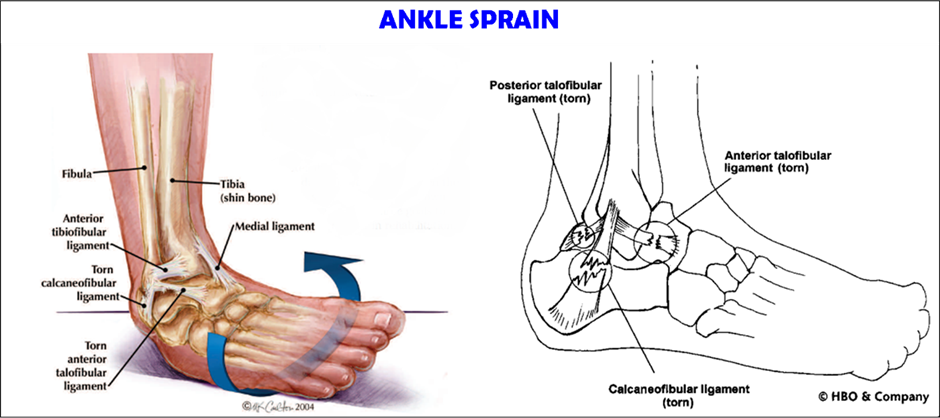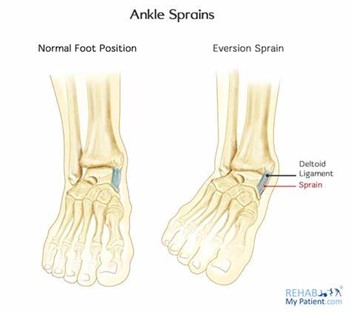Physiotherapy Outpatient Department
On this page
Download leaflet
Ankle Sprains Leaflet PIAG 257 (391kB pdf)
Introduction
The leaflet provides information about ankle sprains for children, parents and carers.
What are ankle sprains?
Ankle sprains are one of the most common orthopaedic injuries. They occur during sudden, awkward twisting movement of the foot. The ligaments of the ankle are stretched beyond their normal range. Sprains are graded as follows:
Grade 1 – Minimal damage occurs. There are no signs of ankle instability. The ankle may be swollen and tender when weightbearing and during certain movements.
Grade 2 – There is partial tearing of the ligaments. There may be mild ankle instability. The ankle may be swollen and tender when weight bearing and during certain movements
Grade 3 – There is complete tear of the ligaments and surgical intervention may be necessary. The ankle will be swollen and you may have some bruising. You will not be able to weightbear through the ankle and movement will cause severe pain.
What is the anatomy of the foot?
On the outside of the ankle, there are three ligaments: anterior talofibular, posterior talofibular and calcaneofibular
The deltoid ligament sits on the inside of the ankle.

This is the most common sprain, when you roll on the outside of your foot, known as an inversion (medial sprain). This can damage your ligaments on the outside of the ankle.

Less commonly, you can roll on the inside of your foot. This is called an eversion (lateral) sprain. This can damage your ligament on the inside of your ankle.
What are the causes?
Medial ankle sprains occur on weight bearing activities when sudden changes of direction are required. The injury occurs due to extreme turning of the ankle outwards.
Lateral ankle sprains occur in extreme inward twisting of the ankle or landing on uneven surfaces
What are the signs and symptoms?
- Audible tearing sound at the time of injury
- Swelling of the foot and ankle
- Bruising around the foot and ankle
- Severe pain
- Inability to stand on your foot and difficulty walking
- Reduced movement in your ankle
How do you treat ankle sprains?
- Rest
- Ice: Apply for 20 mins every 4 hours. Use a towel between your skin and the ice pack. This will help reduce the swelling
- Compression: You can wear an ankle support or tubigrip to help reduce the swelling.
- Elevation: This will reduce the swelling
- Medication: You may find NSAIDs/ anti-inflammatories may help reduce the swelling
- Wear supportive footwear
- Avoid uneven ground as your foot may be susceptible to re-sprain
- Your physiotherapist may give you specific exercises to strengthen your ankle following a sprain
Specific exercises to strengthen your ankle following a sprain
Calf stretch in long sitting
Client’s aim: To stretch your calf muscles
Client’s instructions: Position yourself in long sitting with our knee straight. Place a towel around your foot and gently pull your foot towards your head until you feel a stretch in your calf muscle.
Ankle dorsiflexor strengthening with theraband
Client’s aim: To strengthen your ankle muscles
Client’s instructions: Position yourself lying on your back with some theraband around your forefoot. Adjust the theraband so that the direction of pull is from the foot of the bed. Start with your ankle downwards. Finish with your ankle upwards
Progressions and variations:
Less advanced: 1. Downgrade the colour of the theraband.
More advanced: 1. Upgrade the colour of the theraband
Ankle invertor strengthening using theraband
Client’s aim: To strengthen your ankle muscles.
Client’s instructions: Position yourself lying on your back with some theraband around your forefoot. Adjust the theraband so that the direction of pull is from the outside. Start with your ankle outwards. Finish with your ankle inwards.
Progressions and variations:
Less advanced: 1. Downgrade the colour of the theraband.
More advanced: 1. Upgrade the colour of the theraband.
Ankle evertor strengthening using theraband
Client’s aim: To strengthen your ankle muscles.
Client’s instructions: Position yourself lying on your back with some theraband around your forefoot. Adjust the theraband so that the direction of pull is from the inside. Start with your ankle inwards. Finish with your ankle outwards.
Progressions and variations
Less advanced: 1. Downgrade the colour of the theraband
More advanced: 1. Upgrade the colour of the theraband.
Bilateral calf raises on a block
Client’s aim: To strengthen your calf muscles
Client’s instructions: Position yourself standing on a step with your heels off the edge. Lift your body weight up onto your toes.
Progressions and variations
Less advanced: 1. Provide hand support for balance.
More advanced: 1. Wear a backpack with weights in it. 2. Progress using strength training principles.
Maintaining single-leg stance while rolling a ball around an obstacle
Client’s aim: To improve your ability to weight-bear through your leg.
Client’s instructions: Position yourself standing on your affected leg with your unaffected foot resting on a ball in front of you. Practice rolling the ball in circles around an obstacle on the floor with your unaffected foot.
Progressions and variations:
Less advanced: 1. Roll the ball in smaller circles without an obstacle. 2. Provide hand support for balance.
More advanced: 1. Roll the ball in larger circles. 2. Increase speed of task. 3. Change the direction of roll frequently.
This leaflet only gives general information. You must always discuss the individual treatment of your child with the appropriate member of staff. Do not rely on this leaflet alone for information about your child’s treatment.
This information can be made available in other languages and formats if requested.
PIAG: 257